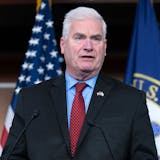Polar Semiconductor hopes federal subsidies will help fund a technology upgrade that will cost at least $420 million and double the output at the Bloomington plant.
Expansion and how to fund it is front of mind as Polar this week hosts semiconductor industry leaders from across the country as they learn more about available new money and talk about how the industry is growing again in the U.S.
The companies of the Fab Owners Alliance are counting on a piece of the $52.7 billion in money from the Creating Helpful Incentives to Produce Semiconductors Act (CHIPS), legislation that President Joe Biden pushed after a semiconductor chip shortage caused backlogs in almost all manufacturing, including automobiles and computers.
The act could translate into "easily over a $1 billion opportunity for the region," said Peter Frosch, CEO of Greater MSP, whose group is leading the Minnesota CHIPS Coalition of government, academia, manufacturers, suppliers and R&D facilities in Minnesota.
Gov. Tim Walz — whose budget includes $500 million in matching funds to leverage federal dollars — addressed the group Tuesday. He recalled Control Data Corp., the computer company that was a giant in its time, as a pioneer that built the foundation for today's chip industry in Minnesota.
"The state needs to be good partners," said Walz, touting support for workforce development and industry expansion to about 100 people gathered in a meeting room at Polar, which is housed in one of the former Control Data buildings.
Applications for some of the first rounds of CHIPS funds are throughout this spring. The federal funds will be in the form of grants, credits, loans or loan guarantees. The U.S. Department of Commerce estimates that most direct funding awards will be in the range of 5% to 15% of a project's capital expenditures.
The money would come at a time when demand is evening out as factories catch up with orders. This is causing hiccups in some companies' expansion plans.



